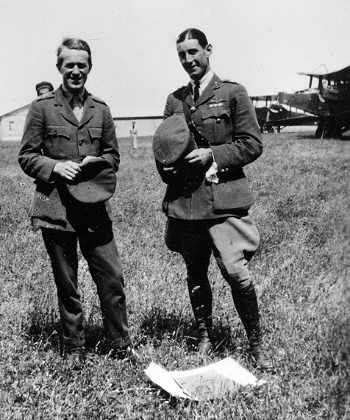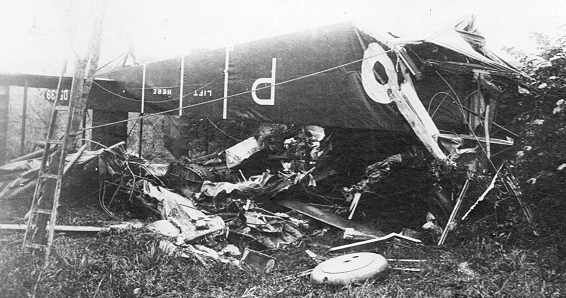FLIGHT INTO EGYPT
With the Arab cause lost, Colonel Lawrence had of necessity, ceased to continue as advisor to Emir Feisal and was thus free to think about and prepare for the writing of his (Lawrence's) 'unique' book on the exploits of the Arab Revolt and his part in it. To start his writing, he needed to collect his diaries and notebooks left in Cairo so, with the permission of Brigadier-General P.R.C. Groves who had been the British Air Representative at the Peace Conference, Lawrence was able to 'hitch an airborne lift' back to the Middle East. This in the end, turned out to be a somewhat more exacting journey than he had expected.
The Royal Air Force had need to get some Handley Page O/400 machines out to Egypt, and it was decided that they would fly them out over stages via France, Italy, Albania, Crete and across the Mediterranean to North Africa and on to Cairo. Three squadrons were to be involved in this epic attempt, No 58, then based at Proven in Belgium was the first to depart on 3 May 1919, the other squadrons being No 214 from Chemy and No 216 from Marquise.
Early in May at Paris, Lawrence caught C9719, aircraft 'H' of 58 Sqn, crewed by Lt S.A. Martindale with 2nd Pilot 2Lt Carl A. Dixon. On reaching Pisa, Lawrence transferred to D5439 'P' of 58 Sqn crewed by 2Lt F.G. Prince, 2Lt S. Spratt with Aircraftsmen Daw and Tunley. Their next stage on 17 May, was to be Rome, but owing to engine problems they did not get away until 17.30 hours, meaning a dusk arrival at Centocelle Aerodrome. The pilot mistook the direction of the wind and made a downwind landing but overran and tried to go round again. It was not to be – the Handley did not climb successfully and a wing hit some trees, causing the machine to crash, ending up inverted.
Lt Prince was killed, while Lt Spratt later died of injuries. The aircraftsmen were shaken-up and Col Lawrence suffered a fractured collarbone and bruised ribs. This put him into hospital and convalescence for three weeks. He was able to continue his journey in mid-June, this time in another 58 Squadron, 'B' Flight, Handley Page, F301 aircraft 'D', piloted by Capt Thomas Henderson MC, his old comrade from the RFC Arabian Detachment. They had not seen each other since July 1917. This part of the journey got them to Suda Bay in Crete, but there the aircraft went u/s with engine problems.
With the total loss of other numerous Handley Pages on the journey, it was necessary to make up the numbers in the squadrons and to do this other sources had to be tapped. One replacement machine was F318 from the 86th (Communications) Wing at Kenley. This aircraft was flying-out a British Foreign Office Diplomat on an urgent mission to see Ibn Saud, who was planning to overthrow Emir Hussein as King of the Hejaz. The emissary was Harry StJohn Bridger Philby and when the aircraft arrived at Suda Bay, Lawrence joined it on 26 June and with Philby, completed his journey to Egypt.
 Col T.E. Lawrence and Capt T. Henderson at Foggia Aerodrome in June 1919. After Lawrence's accident, Henderson was about to fly TEL onwards to Egypt in HP O/400 F301 of 58 Squadron.
Col T.E. Lawrence and Capt T. Henderson at Foggia Aerodrome in June 1919. After Lawrence's accident, Henderson was about to fly TEL onwards to Egypt in HP O/400 F301 of 58 Squadron.
ROSS AND SHAW
Colonel Lawrence wrote the initial version of The Seven Pillars of Wisdom in London over the remarkable period of about five months. In 1927, an abridged version was published, entitled Revolt in the Desert (Jonathan Cape, London). Lawrence went into obscurity, first joining the Royal Air Force in 1922, as 352087 Aircraftsman Ross; was discharged after five months; then joined the Tank Corps as Private Shaw and in mid-1925, transferred back to the RAF as 338171 Aircraftsman/2 Shaw. He latterly worked in the RAF Marine Division on motor-launch development.
Did he choose the name Ross after Major Ross the CO of the Arabian Detachment, whom he had known and liked? Perhaps Lawrence thought to perpetuate the name in RAF history, as Ross had been killed in 1917 in a flying accident? Did Lawrence choose the name Shaw after George Bernard Shaw the author, an admired friend? Lawrence was almost like a son to him.
Lawrence left the Service in February 1935 and, after a motorcycle accident riding his Brough Superior in May of that year, died in hospital a week later. He was buried in the churchyard of St Nicholas Church, Moreton in Dorset, on 21 May 1935. A sad end!
Below - The remains of HP O/400 D5439 inverted near Centocelle Aerodrome, Rome in May 1919. This was the aircraft carrying Col T E Lawrence back to the Middle East and which crash put him in hospital. :JMB/GSL Collection
